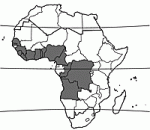Calycobolus heudelotii (PROTA)
Introduction |
| General importance | |
| Geographic coverage Africa | |
| Geographic coverage World | |
| Carbohydrate / starch | |
| Medicinal | |
| Fibre | |
Calycobolus heudelotii (Baker ex Oliv.) Heine
- Protologue: Kew Bull. 16(3): 390 (1963).
- Family: Convolvulaceae
Origin and geographic distribution
Calycobolus heudelotii is distributed from Senegal to DR Congo and Angola.
Uses
In Senegal a decoction of the leaves of Calycobolus heudelotii is taken by draught or used in a steam bath to overcome stiffness and fatigue. In Côte d’Ivoire the pulped bark is massaged onto the stomach to relieve intestinal pain. In Senegal the stems are used for tying in construction of hatched roofs. The flowers are frequented by honeybees.
Botany
Liana up to 15 m long, cylindrical, glabrous, with many pale lenticels. Leaves alternate, simple and entire; stipules absent; petiole 1–4 cm long; blade broadly ovate to elliptical, up to 14 cm × 8 cm, base obtuse, apex emarginate or mucronate, pilose on both surfaces. Inflorescence an axillary cyme, 5–10-flowered; peduncle short. Flowers bisexual, regular, 5-merous; pedicel up to 1 cm long; sepals 5–6 mm long at flowering, external sepals densely hairy outside, internal sepals hairy only along central vein; corolla funnel-shaped, 1.8–2.5 cm long, white, short soft hairy outside, limb with triangular lobes; stamens glabrous, inserted at base of corolla tube; ovary superior, glabrous, 2-celled, style glabrous, stigma 2-lobed. Fruit a conical capsule c. 1.1 cm long, indehiscent, 1-seeded, enclosed in 2 enlarged unequal outer sepals, c. 2 and 6 cm in diameter.
Calycobolus comprises 28 species, of which 25 occur in continental tropical Africa and 3 in tropical America. One species from Madagascar thought to belong to Calycobolus is in fact Bonamia semidigyna (Roxb.) Hallier f. Other Calycobolus species with recorded uses in tropical Africa are Calycobolus africanus (G.Don) Heine and Calycobolus parviflorus (Mangenot) Heine, which occur in wetter areas than Calycobolus heudelotii.
Calycobolus africanus
The range of Calycobolus africanus overlaps with that of Calycobolus heudelotii. In Côte d’Ivoire a decoction of the leaves is taken for lower back pain, and a bath in a decoction of the stem, as well as applying a paste of leaves and stems have aphrodisiac effects. The leaves are eaten or taken in an enema to cure fever. In Cameroon a root decoction is drunk to overcome sexual dysfunction. The flexible stems of Calycobolus africanus are used in Côte d’Ivoire as binding material in construction and the thick woody stems are used to make household goods.
Calycobolus parviflorus
Calycobolus parviflorus occurs in Sierra Leone, Liberia, Côte d’Ivoire and Ghana. In Côte d’Ivoire the powdered bark is taken with food by pregnant women to sooth stomach-ache.
Ecology
Calycobolus heudelotii occurs in drier semi-deciduous forests, woodland and riparian forests.
Genetic resources
There are no specific threats reported for Calycobolus heudelotii and in view of its wide distribution there seems no reason for concern.
Prospects
Calycobolus heudelotii will probably remain locally important especially as a medicinal plant.
Major references
- Burkill, H.M., 1985. The useful plants of West Tropical Africa. 2nd Edition. Volume 1, Families A–D. Royal Botanic Gardens, Kew, Richmond, United Kingdom. 960 pp.
- Heine, H., 1963. The genus Calycobolus Willd. ex. Roem. & Schultes (Convolvulaceae) in Africa. Kew Bulletin 16(3): 387–391.
- Latham, P., 2005. Some honeybee plants of Bas-Congo Province, Democratic Republic of Congo. DFID, United Kingdom. 167 pp.
- Lejoly, J. & Lisowski, S., 1985. Le genre Calycobolus Willd. (Convolvulaceae) en Afrique tropicale. Bulletin du Jardin Botanique National de Belgique 55(1/2): 27–60.
Other references
- Addo-Fordjour, P., Anning, A.K., Larbi, J.A. & Akyeampong, S., 2009. Liana species richness, abundance and relationship with trees in the Bobiri forest reserve, Ghana: Impact of management systems. Forest Ecology and Management 257(8): 1822–1828.
- Betti, J.L., 2004. An ethnobotanical study of medicinal plants among the Baka pygmies in the Dja biosphere reserve, Cameroon. African Study Monographs 25(1): 1–27.
- Hawthorne, W. & Jongkind, C., 2006. Woody plants of western African forests: a guide to the forest trees, shrubs and lianes from Senegal to Ghana. Kew Publishing, Royal Botanic Gardens, Kew, United Kingdom. 1023 pp.
- Latham, P., 2005. Some honeybee plants of Bas-Congo Province, Democratic Republic of Congo. DFID, United Kingdom. 167 pp.
- Lisowski, S., 2009. Flore (Angiospermes) de la République de Guinée: première partie. Scripta Botanica Belgica. Volume 41. Jardin Botanique National de Belgique, Belgium. 517 pp.
- Martins, A.S., Gomes, E.T. & Silva, O., 2008. Caracterizaçâo botânica da liana medicinal da Guiné-Bissau: Calycobolus heudelotii. [Internet] http://www2.iict.pt/ archive/doc/ AS_Martins_wrkshp_plts_medic.pdf. September 2009.
- Neuwinger, H.D., 2000. African traditional medicine: a dictionary of plant use and applications. Medpharm Scientific, Stuttgart, Germany. 589 pp.
- Staples, G.W. & Austin, D.F., 2009. Revision of neotropical Calycobolus and Porana (Convolvulaceae). Edinburgh Journal of Botany 66(1): 133–153.
- Tra Bi, F.H., Kouamé, F.N. & Traoré, D., 2005. Utilisation of climbers in two forest reserves in West Côte d’Ivoire. In: Bongers, F., Parren, M.P.E. & Traoré, D. (Editors). Forest climbing plants of West Africa. Diversity, ecology and management. CABI Publishing, Wallingford, United Kingdom. pp. 167–181.
Author(s)
- C.H. Bosch, PROTA Network Office Europe, Wageningen University, P.O. Box 341, 6700 AH Wageningen, Netherlands
Correct citation of this article
Bosch, C.H., 2011. Calycobolus heudelotii (Baker ex Oliv.) Heine. In: Schmelzer, G.H. & Gurib-Fakim, A. (Editors). PROTA (Plant Resources of Tropical Africa / Ressources végétales de l’Afrique tropicale), Wageningen, Netherlands. Accessed 31 May 2025.
- See the Prota4U database.

